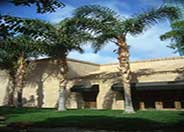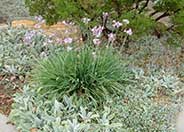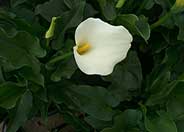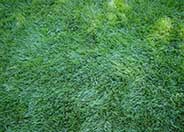
Common name:Queen Palm
Botanical name:Syagrus romanzoffianum
This palm has a very straight trunk to about 50' in height. It has arching, feathery, bright green, glossy leaves that can be 10'-15' long. It is fragile in heavy winds and a fast grower. It will become damaged in temperature below 24 degrees F.

Common name:Japanese Fatsia or Aralia
Botanical name:Fatsia japonica
This evergreen shrub has large, glossy, fan-like leaves that grow to 16" wide. It has a moderate growth rate to a size of 5'-8' that can be kept lower with occasional pruning. It has a very lush, tropical appearance, and grows well in partial shade.

Common name:Society Garlic
Botanical name:Tulbaghia violacea
This clumping perennial will grow less than 1' tall and has narrow, blue green leaves. Clusters of lavender flowers bloom in spring and summer. Leaves and flowers have a distinct onion or garlic smell if crushed.

Common name:Calla Lily
Botanical name:Zantedeschia aethiopica
This perennial will grow 2'-4' tall and has large, glossy green leaves with beautiful cream or white flowers that bloom in spring and sometimes even summer.

Common name:Tall Fescue, Marathon (turf)
Botanical name:Festuca arundinacea 'Marathon'
This grass is best when kept at about 2"-2.5" high, but it has a root depth of about 6'. It is a beautiful, dark green color all year and is used in a variety of locations.
Sustainable Landscaping Fundamentals
Sustainable landscaping is a term coined to mean sensible landscape practices that work within the limits of the Eco-system. This means within the limits of your local rainfall, soil conditions and sun patterns.
Click in the green box for more information
| Designer: | Many Half Trellises |
Photographer: GardenSoft |
Water Saving Tip:
As the weather gets hotter avoid the temptation to increase run times.
Instead, schedule more start times with one to two hours in between to allow the water from the previous session to soak in before watering again.

